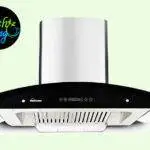
Principle of Vacuum Cleaner
A vacuum cleaner is based on the same principal used in drawing up liquid through a straw. When we suck in at one end of a straw with our mouth, a partial vacuum is created inside the opposite end of the straw. As the air near the top end is drawn into our mouth, the air inside the straw moves upwards creating an empty space at the bottom end.
As a result, the liquid pushes its way in and occupies the space exited by the air. This is because matter has a tendency to occupy space. Also, sucking causes a pressure difference at both ends of the straw. The top end of the straw sees a rise in pressure while the bottom end sees a drop. This induces the liquid, which has a higher pressure than the air at the lower end of the straw, to enter the straw.
A vacuum cleaner relies on centrifugal force to draw up dust. It is fitted with an air pump that creates a partial vacuum and a pressure difference to propel dust through the inlet pipe and into the dust bag at the other end.

You should know : How Does A Robot Vacuum Cleaner Work?
How does Vacuum Cleaner work
A vacuum cleaner consists of a suction port, an exhaust port, a centrifugal fan attached to a motor, a dust bag, a filter and an enclosure for holding all of it together. Upon powering up, the motor starts the fan which collects and shoves chucks of air towards the exhaust vent. This increases the density of air molecules in front of the fan and decreases it behind it.
As a result, atmospheric pressure in front of the fan rises and drops behind it. This causes the air from outside the vacuum cleaner (where the air pressure is higher that behind the fan) to be drawn into the fan, and pumped in the direction of the exhaust. This is called suction and it creates a partially empty space inside the gadget to suck in matter (air and dirt) through friction.
The moving air molecules pick up dust particles through friction and propel them into the cleaner. Once inside, the dirty air is made to pass through a dust bag which acts as a filter. It retains the debris and lets out clean air which is expelled through the outlet port. This is the basic mechanism used by all vacuum cleaners.
Vacuum cleaners come in various sizes and capacities. There are small hand-held cleaners for light cleaning, wheeled canister cleaners for domestic household cleaning, large industrial-grade cleaners for factories and high-capacity vacuum trucks for municipal cleaning. Some vacuum cleaners run on battery and some on direct electricity from wall sockets.
Bernoulli's Principle
Bernoulli’s principle is based on the idea that an increase in the velocity of a liquid or gas leads to a concurrent drop in pressure, whereas a decrease in the velocity of a liquid or gas results in an increase in pressure.
Demonstration of Bernoulli’s principle can be observed in the wing of an airplane. The wing’s shape results in an extended duration of airflow on its surface, leading to increased airspeed and consequent reduction of air pressure. This, in turn, generates lift, relative to the distance covered, the airspeed, and the air pressure experienced beneath the wing.
How Vaccum Cleaners work on Bernoulli’s Principle:
Aspirating a chilled beverage via a straw results in a decrease in pressure between the lower and upper ends of the straw pipe. As a result of the higher fluid pressure at the bottom than the top, the soda is propelled upwards towards your mouth.
Is the vacuum cleaner based on Bernoulli's Principle?
Yes, Vacuum Cleaner likewise operates based on the similar idea. Let’s look at the functioning physical principles of vacuum cleaner, how it generates suction to drive dust into a vacuum area and a basic review of how a vacuum cleaner with regard to its different elements is stated below. The components of a typical hoover cleaner include:
• An electric motor
• A fan
• An input port
• An exhaust port
• A housing
• A porous bag
However, how can a flowing stream of air effectively gather the dirt and particle residue from your carpet? The basic concept is friction. This stream of air operates precisely like a stream of water. The flowing air particles brush against any loose dust or debris as they go, and if the debris is light enough and the suction is powerful enough, the friction propels the material through the interior of the vacuum cleaner. This is the same concept that causes leaves and other trash to float down a stream. Some vacuum cleaners also contain revolving brushes at the intake port, which kick dust and debris free from the carpet so it can be sucked up by the air stream.
As the dirt-filled air finds its way to the exhaust port, it passes through the vacuum-cleaner bag these bags are constructed of porous woven material (usually cloth or paper), which works as an air filter. The tiny holes in the bag are big enough to allow air particles pass by but too small for most dirt particles to fit through. Thus, when the air current streams into the bag, all the air passes on through the material, but the dirt and debris gather in the bag. The strength of the vacuum cleaner’s suction relies on a number of parameters. The suction will be greater or weaker based on:
The power of the fan: The motor which turns at a good speed provides powerful suction,
The blocking of the air passageway: When so much debris gathered in the vacuum bag, the dirt air finds increased difficulty on its journey. The air travels more slowly because of the increased drag. So a vacuum cleaner with a fresh bag performs better.
The size of the aperture at the end of the intake port: If the intake port is tiny, the individual air particles will have to travel considerably more fast in order for them all to get. At the point when the airspeed rises, pressure falls, due of Bernoulli’s principle. The reduction in pressure leads to a larger suction force at the intake port. Because they provide a higher suction force, smaller vacuum attachments may take up heavier dirt particles than broader attachments.


